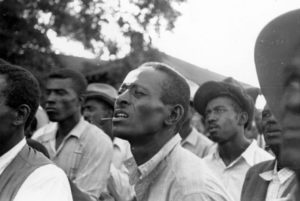
A new study found that institutional racism has an extensive reach into the lives of Black people and has a significant impact on Black economic mobility and the Black-white racial income gap. Even Back boys who are raised in wealthy households grow up earning less than their white counterparts and stand a good chance of emerging in poverty (Photo: Flickr).
The breadth, depth and reach of systemic racism in America is something with which Black people are intimately familiar, as they live the reality of discrimination every day and suffer its consequences. Yet, their experiences are often anecdotal and not data driven, and even if they were, society tends to downplay or even dismiss their cries of injustice and urge them to stop complaining, work harder and pull themselves up by their bootstraps. A new report from The New York Times — based on a study from researchers at Stanford, Harvard and the U.S. Census Bureau — examines race and economic opportunity in the United States, shedding light on racial disparities in income and offering suggestions as to how to overcome them. This intergenerational examination of inequality and how it changes across generations helps to dispel some myths.
Myth #1: It’s about class, not race, and all that Black people need to do is pull themselves up by their own bootstraps
If there is an “American Dream,” that dream is working out for some but not for others, and it is based on race and ethnic group. The study examined the upward and downward mobility of five groups across generations — Hispanics, non-Hispanic whites, African-Americans, Asians and Native Americans — and their future earnings trajectories. Researchers found that Black and American Indian children have far higher rates of downward mobility than any other groups. For example, Black children born into the top quintile on the economic ladder are nearly as likely to fall to the bottom income quintile as they are to remain at the top. In other words, this is a matter of race, not class, as growing up in a high-income household does not provide insurance and guarantee that one will stay there. “Because of these differences in economic mobility, blacks and American Indians are ‘stuck in place’ across generations. Their positions in the income distribution are unlikely to change over time without efforts to increase their rates of upward mobility,” the study said. In addition, while Black children born at the bottom rung of the economic ladder have a 2.5 percent chance of making it to the top rung, this is the case with 10.6 percent of white children.
According to the research, some of the widest racial gaps were found in the wealthiest communities, once again demonstrating that race trumps class in the land of opportunity. Black boys born at the top and falling to the bottom in adult life, along with other Black men who grew up at the bottom and remained there, are part of the same phenomenon and two sides of the same coin. Both types of Black men are victims of the same societal forces that are keeping them down and suppressing their aspirations because of their race.
“One of the most popular liberal post-racial ideas is the idea that the fundamental problem is class and not race, and clearly this study explodes that idea,” @DrIbram told @UpshotNYT. “But for whatever reason, we’re unwilling to stare racism in the face.” https://t.co/Dfe2lkTxJx
— Jamil Smith (@JamilSmith) March 19, 2018
This is the racism we are afraid of: playing an unwinnable game, where lives are at stake.
— Kanyi Maqubela (@km) March 19, 2018
The fact that you, a white man from abject poverty, will attain as much wealth as anyone else who was born into the 30th percentile of wealth is, by definition, what we– or at least I– mean by white male privilege. Not that you’ve always had everything or never faced adversity.
— Jamiles Lartey (@JamilesLartey) March 19, 2018
Myth #2: Black men and women experience the same income gap.
Whether women or men, many Black people are struggling out there in today’s society. With that said, the study concluded that the income gap between Black and white people is driven by the disparities Black men face. Among those people who come from families with comparable incomes, Black women grow up to earn slightly more than white women, with little or no wage gap, while Black men earn considerably less than white men. For men, whether high school completion, college attendance, or incarceration, the racial gap is larger for men than it is for women. Consider that 21 percent of Black men in the lowest family income group are incarcerated, higher than any other demographic. However, Black men raised in millionaire households in the top 1 percent of Americans are as likely to face prison as white men who grew up in homes with annual earnings of $36,000.
While Black women and girls face great inequality on various levels, something is happening to Black boys as they turn into men. While Black and white boys both do better in communities in which there is low poverty, Black boys are faring worse than white boys in 99 percent of census tracts, earning less and having lower economic mobility in adulthood despite coming from the same economic level. These results suggest differences in the ways Black males experience racism, their racial stereotyping as criminals and the school disciplining and employment discrimination they face, as The New York Times notes.
“The worst places for poor white children are almost all better than the best places for poor black children.” https://t.co/8G4dWtF4IE
— scrapper 142 (@vmochama) March 19, 2018
Myth #3: The Black-White gap is due to the “Black family”
While some discussions on racial income inequality may attribute the life outcomes of African-Americans to Black culture, problems with the Black family structure or some innate problems with Black ability, the data from this study dispel those racist notions. For example, as the researchers learned, there are intergenerational gaps between Black and white men, but not for women, making the ability argument implausible. Although there are racial gaps in test scores for men and women — as Black men and women have lower SAT scores than their respective white counterparts, for example — Black women have outcomes similar to white women, suggesting that “standardized tests do not provide accurate measures of differences in ability (insofar as it is relevant for earnings) by race, perhaps because of stereotype anxiety or racial biases in tests,” the study said.
Black marriage rates are much lower than those of whites, meaning lower household income with one breadwinner in the house, which some may attribute to the financial disparities across race. However, the report found that the income gaps between Black men and their white counterparts persist when they grew up in homes with identical family structures and the same income and education levels.
Well, this is probably the most amazing thing I’ll see all week. All downhill from here. https://t.co/ivjpTv4pFN pic.twitter.com/OWE7qdi4NC
— Roberto Rocha (@robroc) March 19, 2018
A lot of interesting prisms for interpreting this data. Among them, I can’t help but notice that if you overlay the generational income graphs on one another, you end up with white men at a supreme wealth retention advantage— and then everyone else. https://t.co/fsCmkZoByy pic.twitter.com/jGX021CDV3
— Jamiles Lartey (@JamilesLartey) March 19, 2018
Myth #4: Nothing can be done
Despite the sobering reality conveyed in this report, the results suggest there are things that can be done to alleviate the crisis of economic inequality and the lack of intergenerational mobility among Black people. In neighborhoods with low levels of poverty, according to the study, there are two factors which translate into better outcomes for Black men and a narrowing of economic disparities: High rates of fathers present in the community — regardless of whether a particular Black man had his father present or whether his parents were married, but rather indicating the role of fathers as role models and their impact on social norms — and low levels of racial bias by white people.
The study found that Black men who move to communities with improved environmental factors — lower levels of racism, poverty and more fathers — find themselves with less prison and higher income. At the same time, Black men who grow up in these communities have a higher risk of downward mobility compared to white men. This shows the racial income gap is not fixed, but rather can be changed.
Myth #5: The solutions to bridging the racial economic gap are simple and easy
Although environment provides a solution to inequality, or at least a cause, the problem with overcoming the economic gap with respect to race is that few Black children are raised in areas that facilitate upward mobility, the study found. While 63 percent of white children are raised in neighborhoods with a poverty rate lower than 10 percent and with over half of fathers present, this is the case for only 5 percent of Black children, according to the report. Further, given that Black and white boys have such dramatically different outcomes when they emerge from comparable family circumstances, the study concludes new policies are required, and solutions such as cash transfers and measures to increase financial resources for the current generation will do nothing to narrow long-term racial disparities unless they impact intergenerational mobility.
“Policies that reduce residential segregation or enable black and white children to attend the same schools without achieving racial integration within neighborhoods and schools would also likely leave much of the gap in place,” the report said. “Initiatives whose impacts cross neighborhood and class lines and increase upward mobility specifically for black men hold the greatest promise of narrowing the black-white gap.” Examples of measures with potential include efforts to reduce racism in the criminal justice system, initiatives to address white racial bias, mentoring programs geared towards Black boys, and efforts to increase cross-racial interaction, according to the report.


